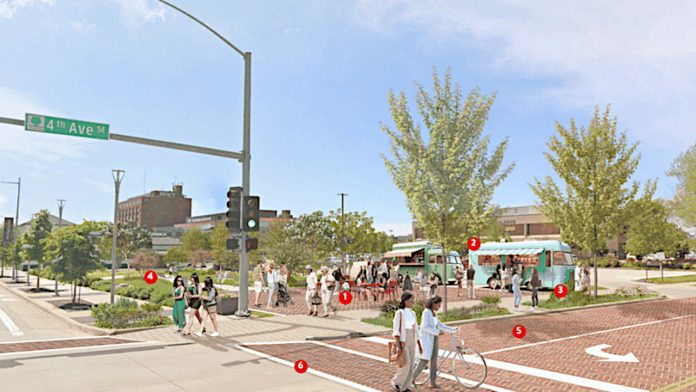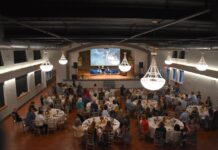
Leaders of Cedar Rapids’ MedQuarter Regional Medical District say their new, updated master plan can build on the successes of the district’s first decade by continuing the development of vacant properties, improving placemaking and wayfinding features and improving the area’s aesthetic appeal to attract and retain visitors. And while the Cedar Rapids City Council voted […]
Already a subscriber? Log in
Want to Read More?
Get immediate, unlimited access to all subscriber content and much more.
Learn more in our subscriber FAQ.
- Unparalleled business coverage of the Iowa City / Cedar Rapids corridor.
- Immediate access to subscriber-only content on our website.
- 26 issues per year delivered digitally, in print or both.
- Support locally owned and operated journalism.
Do you want to read and share this article without a paywall?
Click here to purchase a paywall bypass linkLeaders of Cedar Rapids’ MedQuarter Regional Medical District say their new, updated master plan can build on the successes of the district’s first decade by continuing the development of vacant properties, improving placemaking and wayfinding features and improving the area’s aesthetic appeal to attract and retain visitors.
And while the Cedar Rapids City Council voted unanimously April 9 to adopt the expansive new MedQuarter master plan, several council members are encouraging MedQ leaders to continue their efforts to address safety and development issues and establishing more public gathering spaces in the area.
The MedQuarter District, established in 2014, is one of Cedar Rapids’ three Self-Supporting Municipal Improvement Districts (SSMID), using a self-imposed levy on taxpaying entities in the district to fund specific improvement within the district’s boundaries – projects such as streetscape and beautification work, economic development initiatives and signage.
As implied by its name, the district is comprised mainly of medical businesses, including the city’s two hospitals – UnityPoint-St. Luke’s and Mercy Medical Center – and generally encompasses Tenth Street SE between the two hospitals, as well as most property within two to three blocks east and west of Tenth Street.
In a presentation to the City Council, MedQuarter executive director Phil Wasta said the MedQuarter SSMID board of directors decided at a planning meeting in 2022 that the district’s master plan needed to be refreshed, largely in response to the challenges of the COVID-19 pandemic.
“It was felt that we had accomplished many of the formative initiatives during the course of the previous 10 years, and that much had changed that called for the plan to be refreshed,” Mr. Wasta said.
The board decided to employ the Chicago-based Lakota Group, the urban planning firm which had prepared the MedQuarter’s first master plan, to prepare the update as well.
Lakota Group president Scott Freres told the council that the district has seen substantial success in its first decade, including an estimated $100 million in new development spurred by three main projects – the Physicians’ Clinic of Iowa Medical Pavilion 2, the Jewel & Jim Plumb Heart Center, and the new Cedar Rapids Bank & Trust building.
“The story here is really well-done economic development by the community and the city,” Mr. Freres said. “It is founded in the Medical District … but it's really a story of economic development in a greater downtown, and understanding the benefits that health and wellness, in this particular instance, play a part in the community.”
The original plan focused on four primary pillars: Policy, management and marketing, appearance and identity, and access and infrastructure. The updated plan adds a fifth pillar, Mr. Freres said – community building, designed to integrate the MedQ with the community at large to increase support, collaboration and connectivity.
To those ends, the plan focuses on four guiding principles, including delivering a superior patient experience, improving MedQuarter health care opportunities, actively promoting economic development and contributing to the city’s overall growth.
The plan also advocates for developing more public-private partnerships to help expand the MedQuarter’s public spaces, such as pocket parks, to help break up the district’s expansive areas of concrete and making the area more appealing for visitors to spend time outside.
The plan also suggests creating a MedQuarter Foundation, as a 501(c)3 organization, to pursue grants and other funding sources for district improvements, and suggested partnerships or district expansion, potentially including the Coe College district, to improve development opportunities.
Councilmember Dale Todd said the MedQuarter’s achievements over the past decade have been laudable, including improvements in infrastructure and economic growth, but suggested the possible creation of a development group to forge a “cooperative spirit with the hospitals to partner together and try to tackle some of those languishing parcels that have been out there for a long, long, long time … you still have land banking going on by entities there. That is not doing anybody any good.”
“A lot of the easy stuff has been done,” Mr. Todd added. “Now you're at a point where I think you've got some tough decisions to make … we've got homelessness, and there's a perception there that it's not safe. You're one of the economic engines – when everybody asks why Cedar Rapids does so well, we know it's because of the hospitals. But now it's how do we get to that next level in terms of a real destination place, like you get in Chicago.”
Councilmember Scott Olson concurred, noting that most of the property in the MedQuarter is controlled by the two hospitals and the PCI Medical Pavilion.
“I know there’s been several efforts to put a hotel there for people coming to the hospital,” Mr. Olson said. “The hospitals pretty much own everything. So really, it is in their control, and it is their decision how they use their property. But I think it's important for other businesses (to be there), because we've lost businesses that used to be that area, a lot of the small businesses are now gone, and so it's harder to create that sort of vibe. I think it's getting close. But I think it's an extra push now, to fill in those services that will take it to an experience that everybody feels comfortable with.”
Mayor Tiffany O’Donnell said she felt it was important for the updated plan to include the community-building component.
“That is sort of that intangible next level,” she said. “The best cities have that vibe. What is that? Why are they walking in the same direction, singing the same song? That community building is a huge piece of that.”




